
Pathway to Progress Monitoring
Wake County Public School Systems
Progress Monitoring
- Case managers, teachers of record, related service providers
- One student, one class
- Look at each goal and decide who will progress monitor and where progress monitoring will happen
- Develop common templates to hand to the teacher who will progress monitor
- assess student progress or performance in those areas in which they were identified by universal screening as being at-risk for failure (e.g., reading, mathematics, social behavior)
- the method by which teachers or other school personnel determine if students are benefiting appropriately from the typical (e.g., grade level, locally determined, etc.) instructional program
- identify students who are not making adequate progress
- help guide the construction of effective intervention programs for students who are not profiting from typical instruction (Fuchs & Stecker, 2003)
- Can they pass the stranger test?
- My examples
- It is NOT teacher observation
- Before the semester starts, decide where to progress monitor these goals.
- Regular ed? ICR? CA? Occ Prep? Resource?
- The frequency of progress monitoring should match the level of concern about the student's skill development and need for support
- If monitoring in grade-level materials and the student’s scores fall into the Below Benchmark level, then monitoring one or two times per month is likely sufficient
- If monitoring in grade-level materials for students whose scores fall into the Well Below Benchmark level, then progress monitoring once per week is ideal, though once every other week may be sufficient
Why?
- Right for students
- Students receive more appropriate instruction
- Staff can make informed, instructional decisions regarding specially designed instruction
- Tangible documentation of student progress
- More efficient communication with families and other professionals
- DPI will visit schools and audit individual student records (will be asking for data of progress)
- It is the state and federal policy
- Look at your caseload's goals (***for now only have to start with one student or one class)
- Decide who will progress monitor each goal
- Give that teacher or related services provider the pre-made template
- Develop a schedule of the students you will progress monitor
- Progress Monitor (7-12 data points for each goal throughout the quarter)
- Instruction must be adjusted as needed throughout the data collection process
- Share the data!
Present Levels of Academic Achievement and Functional Performance
Measurable Goals
- Measurable behavior
- Condition
- Criterion
- Stranger Test-could a stranger read the annual goal and know what the skill the learning will be learning and how the student will demonstrate mastery?
- What is the underlying need caused by the disability that if the student mastered that skill would facilitate rapid academic or behavioral growth?
- What goal or few goals would help the student grow the most in the next year?
- Drastically cut back on goals (3-8 goals per student)
1.) By January 2017, when given a literary passage and graphic organizer the student will explain the relationship between: characters, plot, setting, tone, point of view and theme with 85% accuracy. (how do you measure this?)
2.) By the end of the current school year using grade level materials, the student will evaluate the clarity and accuracy of information in non-fiction text, synthesis the information and identify and support a position or argument with 85% accuracy on 4 out of 5 collected work samples. (Is there a rubric involved?)
3.) During Curriculum Assistance, the student will review her student agenda, participate in additional instruction, complete assignments, study, read and organize her folders, binders, 100% of the time. (all of that for 100% of the time?) (how are you measuring participating?) (what is she reading?)
4.) Given a written assignment, the student will use proper grammar with at least 70% accuracy. (just one time?)


